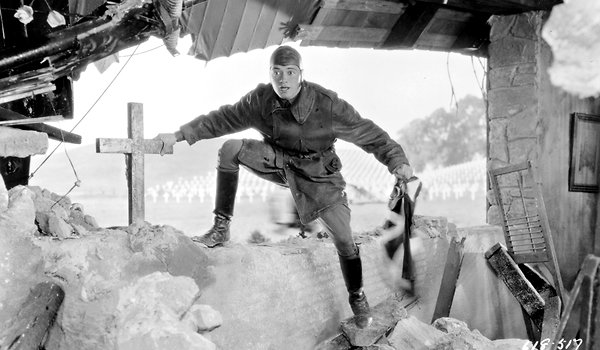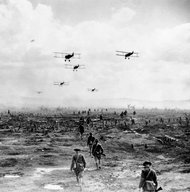Conveniently, Tuesday is also the street date for Paramount Pictures’ truly magnificent, high-definition restoration of William A. Wellman’s 1927 World War I epic “Wings,” which the studio is releasing both as a Blu-ray disc and as a DVD. For those unfamiliar with silent film, this would be a very good place to start.
At the first Academy Awards banquet, held at the Hollywood Roosevelt Hotel on May 16, 1929, “Wings” was honored as the Outstanding Picture of the 1927-28 season, a distinction that over the years has come to be accepted as the Academy’s first Best Picture citation, though that fledgling event also honored F. W. Murnau’s “Sunrise” as the season’s most Unique and Artistic Picture, a category that, unfortunately, had been scuttled by the time the second banquet rolled around.
There were no formal nominations or voting procedures in the early years of the Academy. The winners were simply announced (three months ahead of time for the first awards) by the members of a Board of Judges on Merit Awards. But even if there had been balloting, “Wings” would most likely have been the winner. Still a runaway hit after almost two years, the film was just moving beyond its initial big city, exclusive presentations into national release, re-equipped for its rollout with recorded music and sound effects.
“Wings” possessed many of the qualities that would define future Oscar winners: a huge budget (two million 1927 dollars); a sweeping historical subject that incorporated thrills, romance and sentiment; the leading female star in the country (Clara Bow, at the height of her notoriety as Hollywood’s “It” girl) flanked by a pair of handsome newcomers (Buddy Rogers and Richard Arlen); and an innovative use of technology. (The initial engagements were presented in Magnascope, a process that allows for supersize images for selected scenes, almost exactly as the Imax-ized blockbusters do today.) The modern Oscar winner that “Wings” most closely resembles is James Cameron’s 1997 “Titanic”: a grand entertainment in the something-for-everyone tradition that has been lost in the more recent era of niche marketing. “Sunrise,” though immeasurably the greater film, wouldn’t have had a chance.
Paramount, actually, was coming a bit late to the game with “Wings.” Two previous big studio productions, MGM’s “Big Parade” (directed by King Vidor in 1925) and Fox’s “What Price Glory” (Raoul Walsh, 1926), had already begun the process of romanticizing and reclaiming the traumatic experience of the Great War. But those were films about foot soldiers, while “Wings” — perhaps inspired by the national wave of enthusiasm that accompanied Charles Lindbergh’s 1927 trans-Atlantic solo flight — was about the war in the air, a subject that literally required a new perspective. Paramount’s head of production, B. P. Schulberg, found what he wanted in a young and relatively inexperienced director named William A. Wellman, who had been a fighter pilot with the Lafayette Flying corps during the war and had published a book, “Go, Get ’Em!,” about his experiences.
Today the flying sequences in “Wings” would be executed using digital techniques; in the ’30s and ’40s, they would have been created with a combination of miniatures, rear projection and optical printing. But in 1927 the only way to capture these effects was to perform them in front of live cameras, and Wellman found himself at Fort Sam Houston in San Antonio commanding a 220-plane escadrille staffed by Army airmen and Hollywood stunt flyers.
Because the planes were too small to accommodate an actor, a pilot, a cameraman and a camera, Harry Perry, the director of photography, found a way of mounting a camera in the front cockpit so that it could be operated from the pilot’s seat. Those close-ups of Arlen (who had learned to fly in the Canadian Royal Flying Corps), Rogers (who learned to fly during the production) and their comrades are gripping because they are unshakably, unmistakably real: actors filming their own performances, on sets sailing thousands of feet above the ground.
The emotional core of “Wings” is the intense male romance played out between the Arlen and Rogers characters. Their relationship includes some surprisingly tender scenes of physical affection that our contemporary self-consciousness about such matters would make inconceivable in a mainstream film. Yet Wellman, who would include similar if less explicit scenes in later films, puts all of the film’s dramatic weight behind the male couple, to the point where Clara Bow, the ostensible star, seems excluded from her own movie. (She plays a hometown girl who volunteers as an ambulance driver to be on the same continent with Rogers, the boy next door she has grown up loving.)
Commissioned in commemoration of the 100th anniversary of Paramount’s founding, the present edition of “Wings” is a sterling example of the kind of miracles that can be worked when a major studio throws itself — with support from the Film Foundation — behind a major restoration. Working from the badly damaged duplicate negative that survives in Paramount’s archives, a team of technicians from Technicolor’s Restoration Services stabilized the image, removed dirt and scratches, added the appropriate color tinting and even some hand-stenciled effects (bursts of yellow flame for machine-gun fire) while maintaining the tight grain structure of the original photography.
Accompanied by a five-channel stereo rerecording of the original score composed by J. S. Zamecnik and sound effects supervised by Ben Burtt, “Wings” is about as perfect a presentation of a silent film on a home video format that I’ve ever seen. Here’s hoping that Paramount won’t wait another hundred years before tackling a few more titles from their silent holdings. “The Artist” is a fine film, but it seems very small beside the real thing. (Paramount, Blu-ray $29.99, DVD $15.99, not rated)

